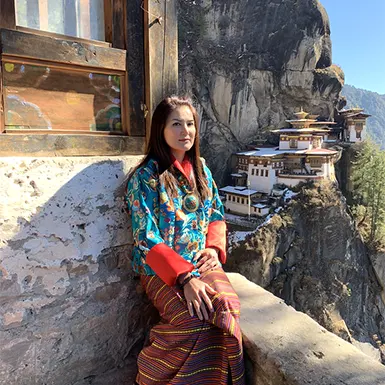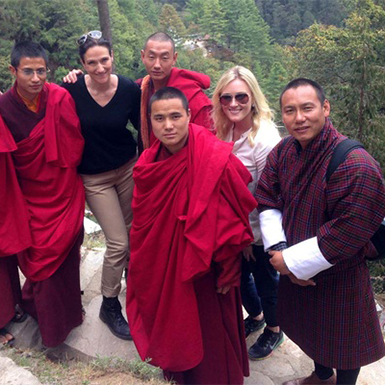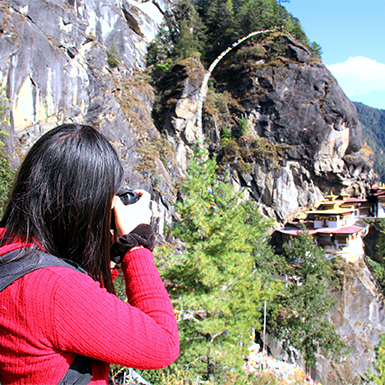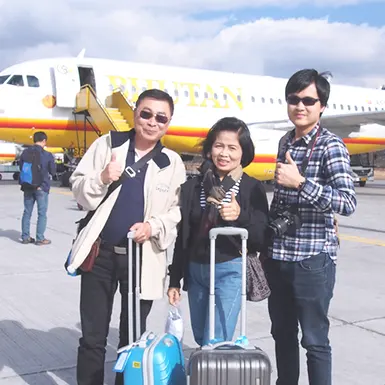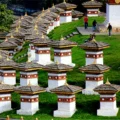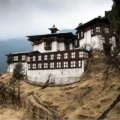Perched on the fort of Rinpung Dzong, Ta Dzong epitomizes Bhutan’s enchanting past and lively culture in Paro Valley. This exceptional round building, originally intended as a watchtower during the 17th century, has now been converted into Bhutan’s National Museum, offering visitors unsurpassed insight into Bhutanese Heritage.
The Watchtower Transformed
Ta Dzong’s unique cylindrical shape sets it apart from other fortresses in Bhutan. Its sturdy stone walls, once guarding against invasions, now protect a treasure trove of artifacts and artistic masterpieces. In 1968, under the guidance of Bhutan’s third king, Jigme Dorji Wangchuck, Dzong was transformed into the National Museum. This endeavor aimed to preserve and showcase the country’s rich cultural legacy for generations.
A Glimpse into Bhutan’s Past
Within the museum’s walls, a captivating collection awaits. As you explore its various floors, you’ll encounter:
- Ancient Masks and Costumes: Witness the intricate craftsmanship of masks used in religious ceremonies and traditional dances.
- Thangkas (Religious Paintings): These vibrant silk paintings depict Buddhist deities and scenes from Bhutanese folklore.
- Bronze Statues and Ritual Objects: Explore Bhutan’s spiritual world through these exquisite pieces of religious art.
- Textiles and Handicrafts: Discover the artistry of Bhutanese weavers and artisans through intricate textiles and handcrafted items.
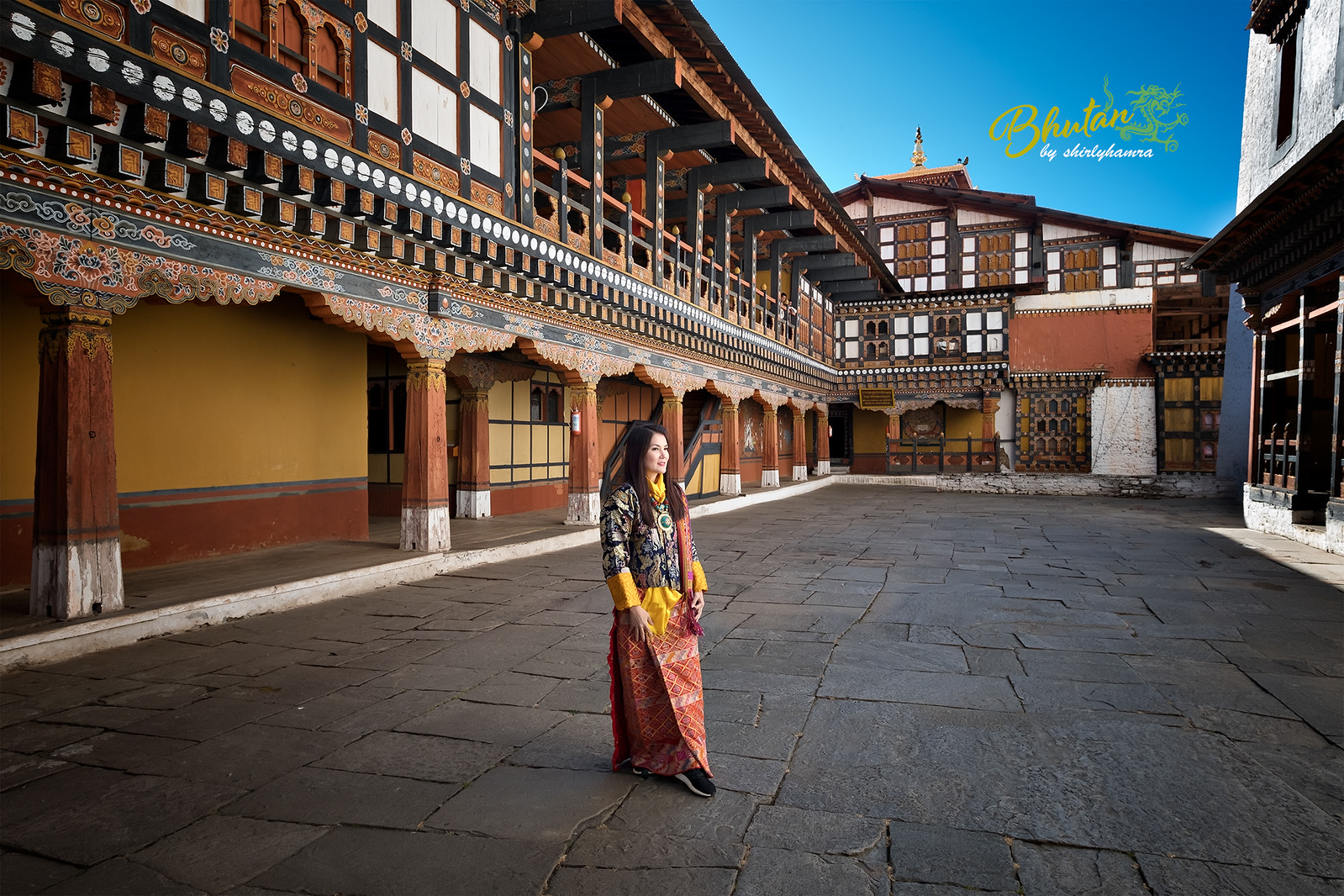
Beyond the Exhibits
It offers more than just a museum experience. The building is an architectural marvel, with its unique circular design and panoramic views of the Paro Valley. Be sure to take a moment to appreciate the tranquility of the museum’s courtyard and the traditional Bhutanese architecture surrounding it.
Discover Bhutan’s National Treasure in Paro
The history of Ta Dzong is as captivating as its architecture. Its trip from a defensive stronghold to a cultural beacon reveals much about Bhutan’s dynamic past.
A Guardian’s Watchful Eye (1649)
In 1649, Tenzin Drukdra, the governor of the Paro Valley and half-brother to Bhutan’s founder Zhabdrung Ngawang Namgyal, initiated the construction of Dzong. Its strategic hilltop position allowed for panoramic views of the surrounding area, making it an ideal watchtower to defend the nearby Rinpung Dzong from potential invasions.
More Than Just Defense
While it served a primarily defensive role in its early years, its unique cylindrical design also hinted at a more profound significance. The structure’s shape symbolizes a conch shell, a sacred Buddhist symbol representing good fortune and prosperity. It suggests that Dzong may have held additional cultural or religious importance beyond its military function.
A New Purpose: The National Museum (1968)
In 1968, King Jigme Dorji Wangchuck, the third king of Bhutan and a visionary leader, recognized Namse Bangdze’s potential as a cultural institution. Under his guidance, the watchtower underwent a remarkable transformation, emerging as the National Museum of Bhutan. This endeavor aimed to preserve and showcase the country’s rich heritage, making it accessible to Bhutanese citizens and international visitors.
Preserving Bhutan’s Legacy
Establishing Namse Bangdze as a national museum marked a significant step in Bhutan’s efforts to protect its cultural identity. It provided a dedicated space for collecting, preserving, and displaying historical artifacts, religious art, and other cultural treasures. Today, it is a reminder of Bhutan’s past and a vibrant cultural exchange and appreciation center.

Ta Dzong: An Architectural Masterpiece of Circular Design
The architecture of Ta Dzong is as captivating as the treasures it houses. Its distinctive circular form and strategic layout offer a unique visitor experience.
A Towering Sentinel: The Circular Structure
Namse Bangdze stands out with its striking cylindrical shape, unlike the rectangular dzongs that dot Bhutan’s landscape. This design was not just aesthetic; it served a practical purpose. The round structure offered defenders a 360-degree view of the surrounding valley, enabling them to detect approaching threats from all directions. Additionally, the need for corners made it easier for invaders to scale the walls.
Seven Floors, Seven Stories
The National Museum of Bhutan Interior is a fascinating trip through Bhutan’s history and culture. Each of its seven floors represents a different historical and cultural period, with exhibits carefully curated to immerse visitors in the essence of each era.
- Ground Floor: This level typically houses temporary exhibits and provides an introduction to the museum’s diverse collections.
- First Floor: Explore the natural history of Bhutan through displays of flora, fauna, and geological specimens.
- Second Floor: Delve into Bhutan’s spiritual traditions through exhibits of thangkas (religious paintings), bronze statues, and ritual objects.
- Third Floor: Discover the rich tapestry of Bhutanese textiles, showcasing intricate weaving techniques and traditional patterns.
- Fourth Floor: Witness the artistry of Bhutanese artisans through displays of weaponry, armor, and household items.
- Fifth Floor: Gain insight into Bhutan’s royal heritage through a collection of royal artifacts, including crowns, robes, and ceremonial objects.
- Sixth Floor: This level houses a chapel dedicated to the museum’s founder, King Jigme Dorji Wangchuck.
Architectural Details to Admire
As you wander through Dzong, pay attention to its architectural details:
- Spiral Staircase: A central spiral staircase links all seven floors, providing views of the exhibits as you climb.
- Windows and Balconies: Thoughtfully positioned windows and balconies flood the space with natural light and offer stunning vistas of the surrounding landscape.
- Woodwork and Paintings: The museum’s interior walls are adorned with intricate woodwork and colorful paintings, adding to its aesthetic appeal.
Ancient Artifacts and Historical Treasures
Ta Dzong’s collection spans centuries, showcasing artifacts illuminating various aspects of Bhutanese life and history.
- Religious Relics: Encounter statues, ritual objects, and other sacred items used in Buddhist ceremonies, providing insight into Bhutan’s deep-rooted spiritual traditions.
- Weapons and Armor: Examine swords, daggers, bows, and arrows from Bhutan’s warrior past, reflecting the country’s history of defense and valor.
- Household Objects: Explore everyday items like pottery, tools, and kitchen utensils, offering a glimpse into the daily lives of Bhutanese people through the ages.
Vibrant Thangkas and Exquisite Textiles
The National Museum of Bhutan houses an impressive collection of thangkas, traditional Tibetan Buddhist paintings on silk or cotton.
- Religious Themes: Admire thangkas depicting Buddhist deities, mandalas (symbolic representations of the universe), and scenes from Buddhist teachings.
- Historical Narratives: Discover thangkas that recount historical events, legends, and folktales, adding depth to Bhutan’s cultural tapestry.
- Textile Treasures: You can marvel at the intricate weaving techniques and vibrant colors of Bhutanese textiles, including traditional clothing, ceremonial robes, and everyday garments.
A Glimpse into Bhutan’s Natural World
Ta Dzong’s natural history gallery offers a fascinating look at Bhutan’s unique biodiversity and geological features.
- Flora and Fauna: Encounter preserved specimens of Bhutan’s diverse plant and animal life, from rare orchids to majestic snow leopards.
- Geological Wonders: Explore the country’s geological history through exhibits of fossils, minerals, and rocks, providing insight into the land’s formation and evolution.
- Environmental Conservation: Learn about Bhutan’s commitment to environmental sustainability and its efforts to protect its pristine natural resources.

Guardian of Bhutanese Culture and Spirituality
Ta Dzong is more than just a museum; it’s a living testament to Bhutan’s rich cultural heritage and deep-rooted spiritual traditions. Its exhibits and collections offer a window into the heart of Bhutanese identity.
Preserving a Living Legacy
As the National Museum of Bhutan, Namse Bangdze is crucial in safeguarding cultural heritage. Its mission goes beyond simply displaying artifacts; it actively works to preserve and promote Bhutan’s unique traditions for future generations.
- Collection and Conservation: The museum collects and preserves various cultural objects, from ancient manuscripts and religious artifacts to traditional textiles and handicrafts.
- Research and Education: Namse Bangdze researches Bhutanese history, art, and culture and shares its findings through publications, exhibitions, and educational programs.
- Cultural Exchange: The museum actively engages in cultural exchange initiatives with other institutions worldwide, fostering a deeper understanding and appreciation of Bhutanese heritage.
Religious Artifacts and Their Significance
Bhutanese people weave Buddhism into the fabric of their daily lives, making the country deeply religious. Dzong’s collection reflects this spiritual foundation through various religious artifacts.
- Statues of Buddhist Deities: These statues, often crafted from bronze or other metals, depict various Buddhas, bodhisattvas (enlightened beings), and other figures revered in Bhutanese Buddhism.
- Ritual Objects: Explore various ritual objects used in Buddhist ceremonies, including prayer wheels, offering bowls, and ceremonial instruments.
- Sacred Texts and Manuscripts: Discover ancient texts and manuscripts written in Dzongkha (the national language) and Tibetan, containing Buddhist teachings, historical accounts, and philosophical treatises.
Festivals and Celebrations
Ta Dzong and the adjacent Rinpung Dzong play a central role in several critical religious festivals and events held throughout the year.
- Paro Tshechu: This vibrant four-day spring festival features masked dances, religious rituals, and colorful processions. It’s a major highlight on Bhutan’s cultural calendar.
- Paro Tsepamey Tamchog Lhakhang Drubchen: This annual ceremony, held in the fall, involves the unveiling of a giant thangka (religious scroll painting) depicting Guru Rinpoche, a revered Buddhist master.
Ta Dzong: An Enriching Visitor Experience
Once a watchtower, the National Museum of Bhutan now captivates visitors as a museum in Paro. It offers panoramic valley views and features a rich collection of Bhutanese cultural artifacts, traditional costumes, and religious paintings. Visitors can delve into Bhutanese history and heritage, making it an essential stop for understanding the country’s vibrant traditions.
Guided Tours and Educational Programs
It offers guided tours that enhance your visit and provide deeper insights into the museum’s collections and the stories they tell.
- Knowledgeable Guides: The museum’s guides are well-versed in Bhutanese history, art, and culture. They share captivating stories and answer questions, enriching your understanding of the exhibits.
- Thematic Tours: The National Museum of Bhutan offers specialized tours focusing on specific themes, such as religious art, textiles, or historical periods, allowing you to tailor your experience to your interests.
- Educational Programs: The museum also hosts educational programs for students and adults, including workshops, lectures, and cultural demonstrations, fostering a greater appreciation for Bhutanese heritage.
Panoramic Views of the Paro Valley
One of Ta Dzong’s most alluring features is its breathtaking vantage point. The museum’s location on a hilltop offers panoramic views of the picturesque Paro Valley and the iconic Rinpung Dzong.
- A Photographer’s Paradise: The scenery from the National Museum of Bhutan is a photographer’s dream, with the valley’s lush greenery, traditional Bhutanese houses, and the majestic Dzong providing stunning backdrops.
- A Moment of Tranquility: Take a break from exploring the exhibits to relax on the museum’s terrace or courtyard. Here, you can enjoy the serene atmosphere and admire Bhutan’s natural beauty.
Special Exhibitions and Temporary Displays
The National Museum of Bhutan regularly hosts special exhibitions and temporary displays that complement its permanent collection. These exhibitions often highlight specific themes or showcase contemporary Bhutanese artists’ works, offering fresh insights into Bhutan’s vibrant cultural scene.
Tips for Visiting Ta Dzong
- Plan Your Time: Allow ample time to explore the museum’s various floors and exhibits.
- Check for Photography Restrictions: While photography is allowed in some areas, specific exhibits may have restrictions.
- Respectful Attire: The National Museum of Bhutan is a place of cultural and religious significance, so visitors must dress modestly.
- Stay Informed: Check the museum’s website or inquire at the entrance for information about any special events, temporary exhibitions, or guided tours that may be available during your visit.

Finding Your Way to Bhutan’s Cultural Heart
Located in the scenic Paro Valley, Ta Dzong is easily accessible, making it a convenient and rewarding addition to your Bhutan itinerary.
Where is Ta Dzong Located?
The National Museum of Bhutan overlooks the town of Paro from its hilltop perch in western Bhutan. It’s a short distance from the Paro International Airport, making it a convenient first or last stop for travelers.
Getting to Ta Dzong
There are several ways to reach the National Museum of Bhutan:
- From Paro International Airport: The museum is just 15 minutes away. You can book a taxi or private transfer by requesting it from your hotel or tour operator.
- From Paro Town: It is just a short uphill hike from Paro Town. The 20-30-minute walk provides scenic views of the surrounding valley.
- By Car or Taxi: Taxis are available in Paro town if you prefer to avoid walking. You can also arrange a car and driver through your hotel or tour operator.
Planning Your Trip to the National Museum of Bhutan
Ta Dzong is open daily, except on government holidays. The museum operates from 9:00 a.m. to 4:00 p.m. For the latest information, please consult the official website or ask locally.
Whether you arrive by foot, car, or taxi, the tour to Dzong is part of the experience. The scenic surroundings and cultural landmarks surrounding it make the museum a must-visit destination for anyone exploring the wonders of Bhutan.
Must-Visit Attractions Near Ta Dzong
- Rinpung Dzong (Paro Dzong): This majestic fortress, located just below the National Museum of Bhutan, is a masterpiece of Bhutanese architecture. Explore its courtyards, temples, and administrative offices, and witness the daily lives of monks and government officials.
- Kyichu Lhakhang: One of Bhutan’s oldest and most sacred temples, Kyichu Lhakhang, dates back to the 7th century. Admire its ancient murals, golden roofs, and serene atmosphere.
- Taktsang Monastery (Tiger’s Nest): The ascent to this iconic cliffside monastery is challenging, yet it rewards breathtaking views and a profound sense of spiritual awe.
- Paro Weekend Market: Browse this lively market to experience local life and find fresh produce, handicrafts, and souvenirs.
- National Museum of Bhutan: This museum, located in a traditional Bhutanese house, is a place to discover Bhutan’s contemporary art and craft traditions.
Suggested Itineraries
Here are a few itinerary ideas to help you make the most of your time in Paro:
Option 1: Ta Dzong and Rinpung Dzong (Half-Day)
- Start your day at the National Museum of Bhutan, exploring its exhibits and enjoying the views.
- Describe Rinpung Dzong, where you can delve into its history and architecture.
Option 2: Ta Dzong, Rinpung Dzong, and Kyichu Lhakhang (Full-Day)
- Follow Option 1, adding a visit to the serene Kyichu Lhakhang in the afternoon.
Option 3: Ta Dzong, Rinpung Dzong, and Taktsang Monastery (Two Days)
- Day 1: Explore the National Museum of Bhutan and Rinpung Dzong leisurely.
- Day 2: Begin the exhilarating hike to Taktsang Monastery in the morning and return in the afternoon.
Option 4: Paro Cultural Immersion (Three or More Days)
- Combine visits to the National Museum of Bhutan, Rinpung Dzong, Kyichu Lhakhang, and Taktsang Monastery with additional cultural activities.
- Consider trying archery (Bhutan’s national sport), attending a traditional mask dance performance, or visiting a local farmhouse to glimpse rural life.
Ta Dzong: A Journey Worth Taking
Ta Dzong is more than just a museum; it’s a portal to Bhutan’s rich history, vibrant culture, and spiritual traditions. Its unique architectural design, diverse collections, and breathtaking views offer an unforgettable experience.
Key Takeaways
- A Historic Watchtower Transformed: Originally built as a defense in 1649, authorities repurposed Ta Dzong as Bhutan’s National Museum in 1968.
- Architectural Marvel: The circular structure, designed for protection, now offers panoramic views of the Paro Valley.
- Cultural Treasure Trove: The museum’s seven floors house a vast collection of artifacts, religious relics, thangkas, textiles, and more, spanning centuries of Bhutanese history and culture.
- Spiritual Significance: Ta Dzong is crucial in preserving Bhutan’s religious heritage. Its exhibits showcase Buddhist statues, ritual objects, and sacred texts.
- Nearby Attractions: Paro offers a wealth of additional attractions, including Rinpung Dzong, Kyichu Lhakhang, and Taktsang Monastery.
An Invitation to Explore
Ta Dzong welcomes visitors to discover Bhutan’s heart and soul. Whether you’re a history enthusiast, an art lover, a spiritual seeker, or simply curious about this enchanting kingdom, Ta Dzong offers a trip of discovery you will remember.
Prepare your visit to Ta Dzong to explore the rich tapestry of Bhutanese heritage. Let the museum’s treasures and stories transport you to a world of ancient traditions, vibrant art, and profound spirituality.
Your Bhutanese adventure awaits – start planning today!

